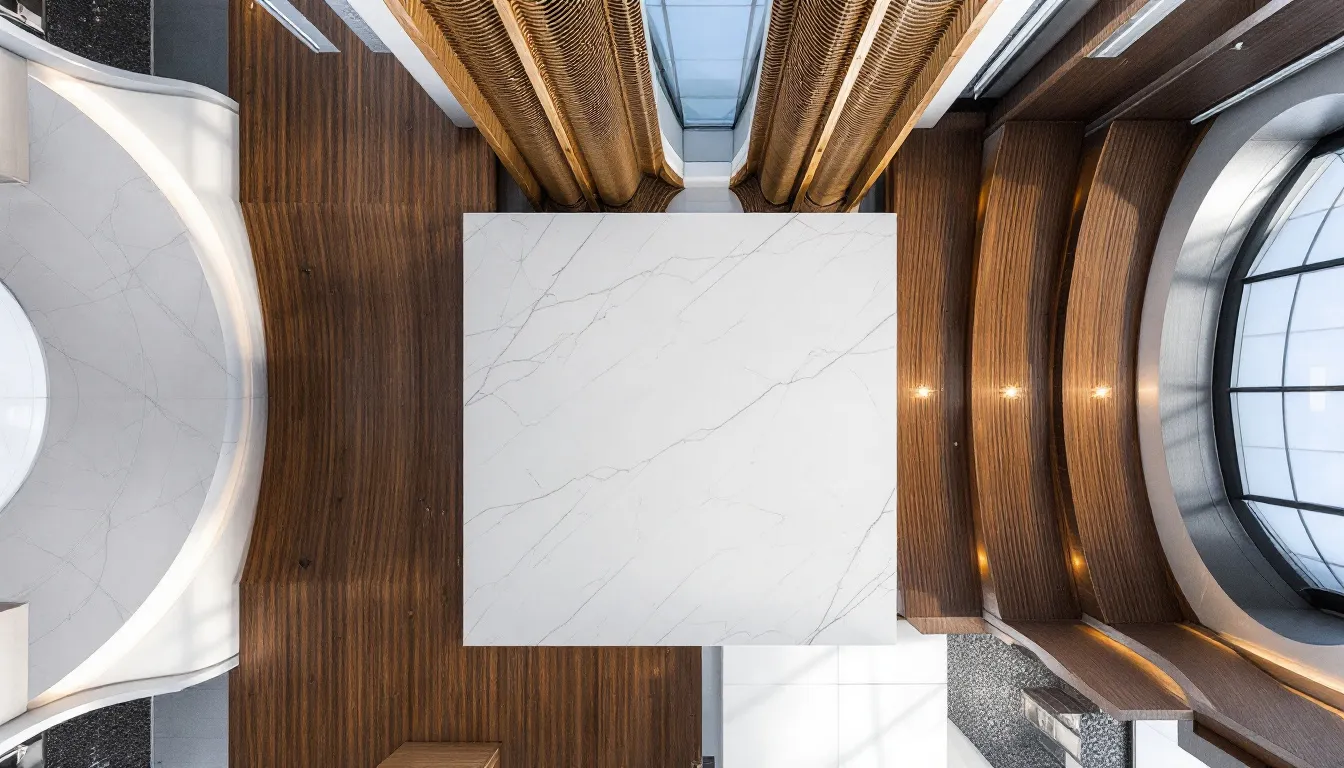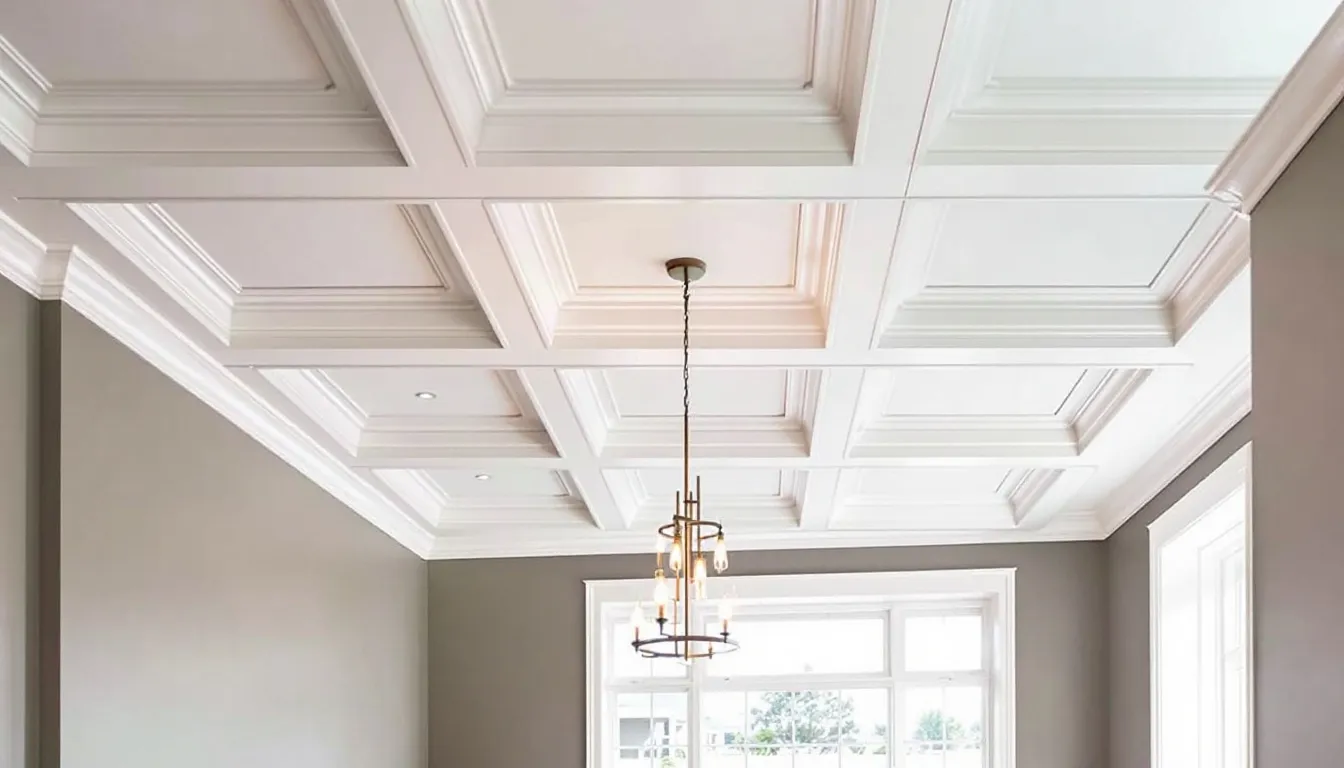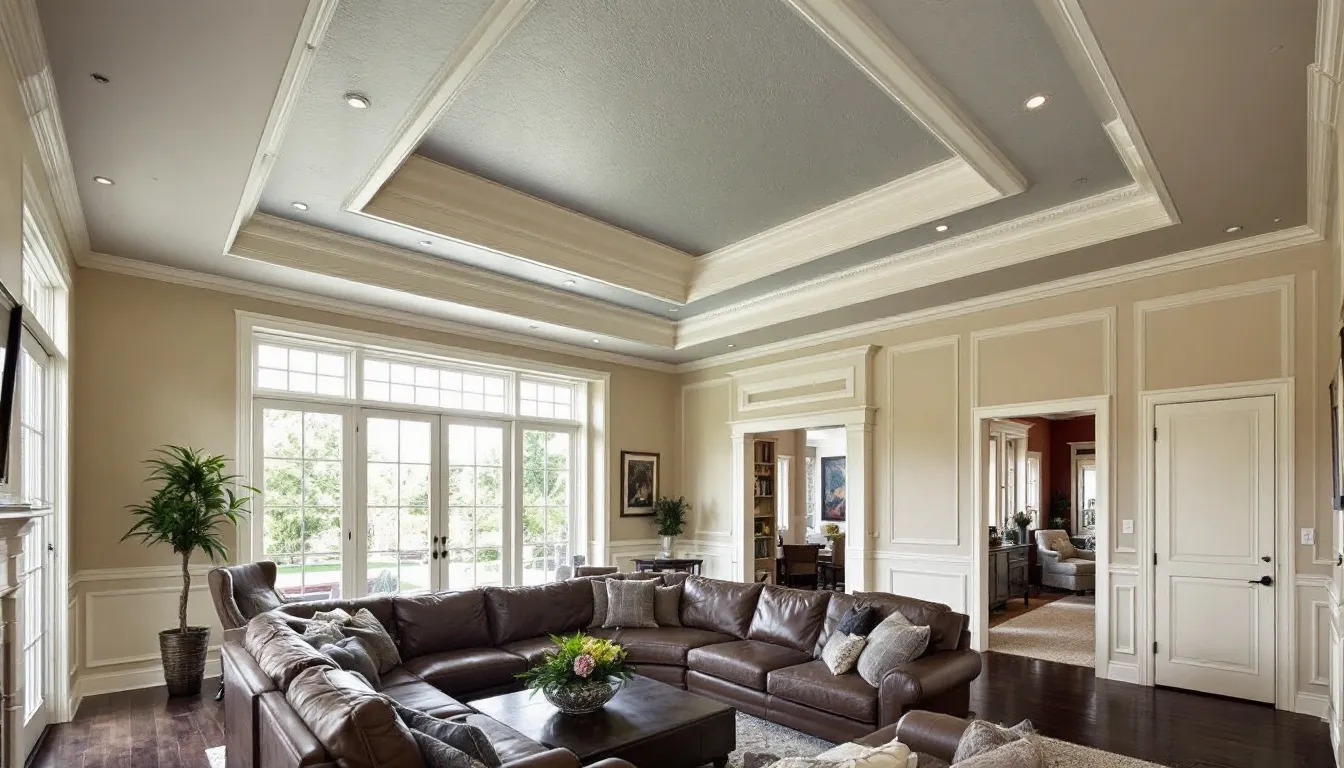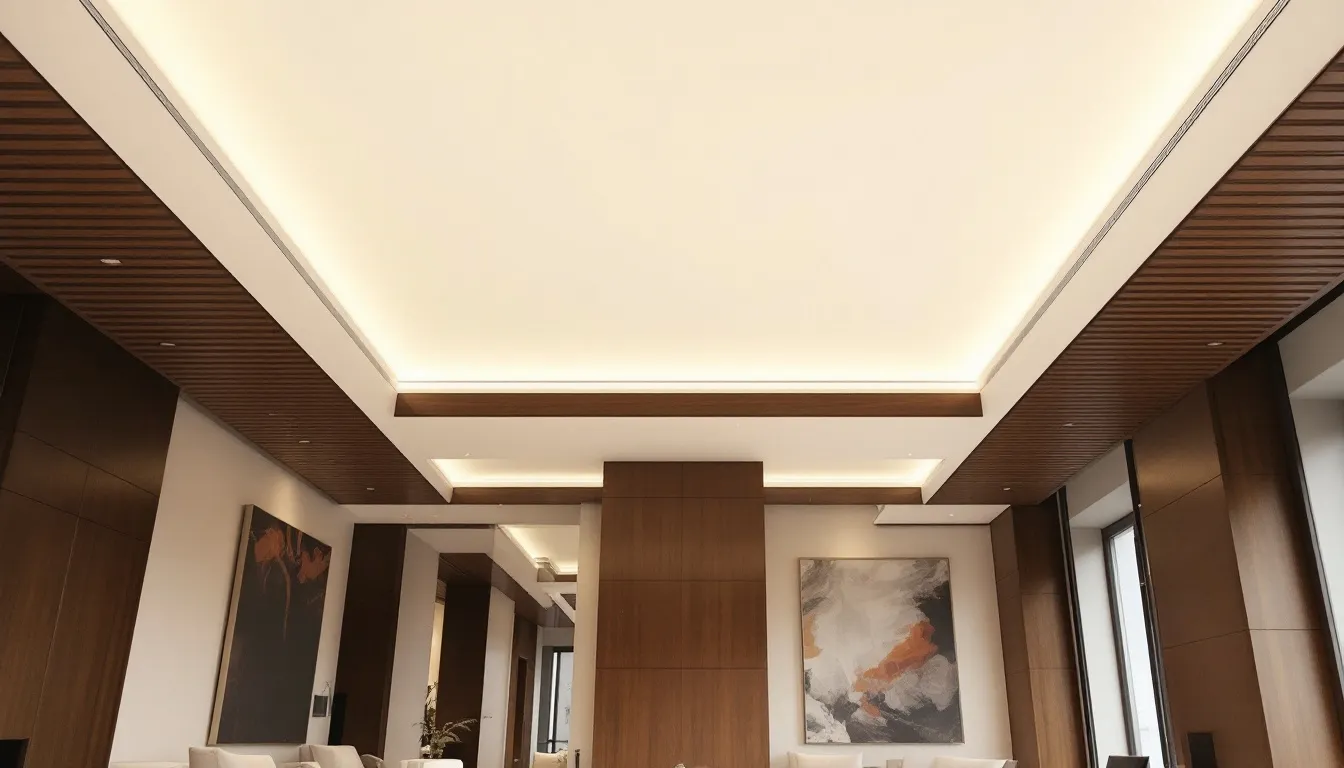Considering a home upgrade? Understanding the types of ceilings available is crucial. This article outlines 12 popular ceiling types, highlighting their features and benefits to help you choose the best fit for your space.
Key Takeaways
- Conventional ceilings are budget-friendly and easy to maintain, making them a popular choice, despite their lower height.
- Coffered and tray ceilings add elegance and can dramatically enhance the visual height and spaciousness of a room.
- Modern options like stretch and vaulted ceilings offer unique design possibilities that can increase property value and improve natural light.
Conventional Ceilings
Conventional ceilings and existing ceiling options are a staple in North American homes. Typically flat and finished with drywall ceilings, these practical and budget-friendly ceilings are straightforward to install and maintain. With standard ceiling height ranging from 8 to 9 feet, these ceilings options remain a popular choice for homeowners.
Their lower height can sometimes make a room feel cramped. Nevertheless, the low maintenance and cost-effectiveness of conventional ceilings make them a reliable choice.
Suspended Ceilings
Suspended ceilings, or drop ceiling, offer a versatile and practical solution for both residential homes and commercial spaces. These ceilings consist of a grid framework of metal channels and a metal grid holding ceiling tiles, making them easy to install and maintain. Their flexibility in design and customization options is a standout feature of the suspended ceiling.
Besides aesthetics, suspended ceilings provide easy access to utilities like electrical wires, plumbing systems, lighting, and air conditioning ducts, making them excellent for spaces requiring frequent maintenance or updates. Damaged tiles can be easily replaced without disrupting the entire ceiling.
Coffered Ceilings
Coffered ceilings epitomize elegance and sophistication. Featuring recessed panels that create a grid-like pattern, these ceilings add depth and architectural interest to any room, offering a subtle look that enhances the overall design. Whether deep or shallow, they bring undeniable visual weight and luxury to a space, showcasing unique ceiling features.
These intricate designs typically require skilled installation, often by specialists who can maximize their aesthetic potential. Historically found in high-end homes, churches, and libraries, coffered ceilings have a timeless appeal that elevates any room’s ambiance.
Coffered ceilings have recently regained popularity due to their endless design possibilities. From traditional wood ceilings frames to modern homes materials, they can be customized to suit various ceiling types and ceiling type, as well as different types of ceilings and ceiling styles and ceiling style, making them a versatile choice for any home. Additionally, incorporating a wood ceiling can enhance the overall visual appeal, contributing to a contemporary style. There are numerous ceiling options available to further personalize your space.
Tray Ceilings
Tray ceilings, with their recessed design and high center, create a stunning visual effect resembling inverted panels. This multi-level ceiling design adds a three dimensional effect to the room, making the space feel taller and more spacious. The design intent of the ceiling layout resembles enhances this effect further.
The dramatic impact of a this ceiling can transform a room, making it look more luxurious and expansive. Whether renovating your dining room or adding elegance to your bedroom, a tray ceiling significantly enhances the overall aesthetic and visual height of the space.
Coved Ceilings
Coved ceilings have a concave ceiling design with rounded angles where walls meet the ceiling, creating a softer, more elegant appearance. The gentle curves and curved edges, along with curved molding, can make a space feel more inviting and graceful, enhancing the overall aesthetic.
Besides their visual appeal, coved ceilings can serve as architectural elements, acting as an archway between adjoining rooms. However, their installation can be more complicated and costly due to their intricate construction.
Cathedral Ceilings
Cathedral ceilings, often referred to as sloped ceilings, feature an inverted V-shape that brings a dramatic and open feel to any space. Commonly found in large living rooms, dining rooms, and master bedrooms, these types of ceilings significantly enhance a room’s aesthetic and spaciousness.
Cathedral ceilings come with their own set of challenges. Painting or reaching fixtures can be difficult due to the high slope, and they may pose energy consumption and ventilation issues. Despite these, the grandeur and openness they provide make them a favorite in many homes.
Shed Ceilings
Shed ceilings are unique and modern, characterized by single slope ceilings in one wall direction. These types of ceilings typically found in tighter spaces like attics and lofts, they provide a sleek and contemporary look that aligns well with minimalist design trends, especially with a shed ceiling aesthetic.
Shed ceilings are highly versatile. They can be crafted from various materials, including metal panels and wood finishes, offering a wide range of aesthetic choices. In open-concept designs, shed ceilings can incorporate beams to visually separate spaces while maintaining an open and airy feel.
Beamed Ceilings
Beamed ceilings are a timeless choice that add architectural interest and character to any space. Featuring exposed load-bearing beams, these ceilings are both functional and aesthetically pleasing. Common materials include natural wood, hardwoods, and Douglas fir, contributing to their visual appeal and durability.
Historically, beamed ceilings were used in older homes to increase headspace and showcase support beams. Today, they are versatile enough for various rooms, including hallways, corridors, living rooms, and dining rooms. Decorative beams, made from materials like plywood and miters, serve purely aesthetic purposes and offer versatile installation options.
However, room size is important to consider when installing beamed ceilings. In smaller spaces, beams can overwhelm the room if not carefully placed. The cost of installing decorative beams varies, with real wood being more expensive than composite alternatives.
Exposed Ceilings
Exposed ceilings reveal the building’s structural elements, creating a modern industrial look that is both stylish and functional. This design vision is perfect for those who appreciate a raw, unrefined aesthetic appeal. Elements like piping, exposed beams, and Edison bulbs can enhance the visual appeal of the space, especially when complemented by exposed ceiling beams.
Careful planning is necessary to manage acoustics in spaces with exposed ceilings. Without proper acoustic treatment, these ceilings can lead to noise-related challenges, especially in workplaces.
Despite this, exposed ceilings are popular in creative and open-office designs due to their unique and trendy appearance.
Acoustic Ceilings
Acoustic ceilings improve sound insulation using specialized materials like mineral fiber or fiberglass. These ceilings are particularly beneficial in environments where noise reduction is crucial, such as offices and educational institutions. By absorbing echoes and reducing background noise, they enhance sound clarity and overall comfort.
Exposed ceilings, while visually appealing, can lead to noise-related challenges. Incorporating sound-absorbing materials can help mitigate these issues without compromising visual appeal. Common materials used in acoustic ceiling tiles include mineral fiber and fiberglass, enhancing acoustic performance by damping reverberations and addressing problematic frequencies.
Stretch Ceilings
Stretch ceilings offer a sleek and modern aesthetic that can be customized into various creative shapes, including waves and vaulted designs. Made from PVC or fabric membranes, these types of ceilings come in numerous finishes and bespoke printed options, allowing for endless design possibilities with stretch ceiling.
One of the main advantages of stretch ceilings is their ease of installation process when installed correctly. The process is quick, affordable, and mess-free, making them a convenient choice for homeowners looking to enhance their space without a lengthy renovation.
Vaulted Ceilings
Vaulted ceilings and high ceilings are a stunning addition to any living space, significantly enhancing brightness and creating a sense of spaciousness. Their height can make a room feel like large spaces and more open, adding an atmosphere of elegance and grandeur.
There are various styles of vaulted ceilings, including domed, barrel, groin, and rib designs. Barrel-vaulted ceilings feature an arch that extends from one side to the other, creating a timeless aesthetic. Dome ceilings, characterized by their half-sphere shape, enhance airiness and increase the perceived size of the room.
Raising conventional ceilings to create a vaulted effect can be a significant investment, but it can also increase the property’s value and enhance the room’s natural light, especially with skylights incorporated.
Summary
In summary, the type of ceiling you choose can significantly impact the overall look and feel of your space. From the practical and budget-friendly conventional ceilings to the luxurious and intricate coffered ceilings, each option offers unique benefits and aesthetic appeal. Types of ceilings you’re aiming for a modern industrial look with exposed ceilings or a timeless elegance with vaulted ceilings, there’s a ceiling type to suit every style and need.
We hope this guide has inspired you to explore the various ceiling options available and consider how they can enhance your home’s interior. Remember, the right ceiling can transform a room, making it more inviting, functional, and visually appealing.
Frequently Asked Questions
What are the benefits of a suspended ceiling?
These are great because they provide easy access to utilities and are simple to install and maintain. Plus, they can really enhance the look of a room by hiding wires and ducts.
Are coffered ceilings suitable for modern homes?
Absolutely, coffered ceilings can add a stylish touch to modern homes. Their customizable designs allow you to blend elegance with contemporary aesthetics seamlessly.
How do tray ceilings affect the perception of a room’s height?
Tray ceilings enhance a room’s perceived height by drawing the eye upward with their multi-level design. Interior designers often recommend them to create a taller, more open feel without major renovations. Their elegant, customizable style suits both residential and commercial spaces, adding depth and visual interest.
What materials are commonly used for beamed ceilings?
Beamed ceilings commonly use hardwoods and Douglas fir for their durability, natural beauty, and classic style. These materials provide strong structural support while adding warmth and character to any room. In addition to solid wood, decorative beams made from plywood or composite materials are also popular, offering a more versatile and budget-friendly option that can mimic the look of real wood. This makes beamed ceilings accessible for both residential and commercial buildings.
What are the advantages of stretch ceilings?
Stretch ceilings are a fantastic choice if you want a stylish, modern look that can be customized to fit your space perfectly. Made from flexible PVC or fabric membranes, they can be designed in various shapes, colors, and finishes to complement any interior design. One of their key benefits is the quick and affordable installation process, which minimizes disruption and mess, making them ideal for both homes and commercial buildings such as retail spaces and office environments. Additionally, stretch ceilings offer excellent durability enhancing both the functionality and visual appeal of commercial environments.





